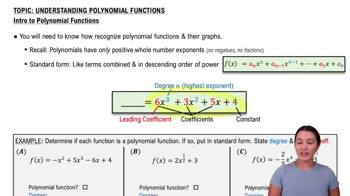Table of contents
- 0. Functions7h 52m
- Introduction to Functions16m
- Piecewise Functions10m
- Properties of Functions9m
- Common Functions1h 8m
- Transformations5m
- Combining Functions27m
- Exponent rules32m
- Exponential Functions28m
- Logarithmic Functions24m
- Properties of Logarithms34m
- Exponential & Logarithmic Equations35m
- Introduction to Trigonometric Functions38m
- Graphs of Trigonometric Functions44m
- Trigonometric Identities47m
- Inverse Trigonometric Functions48m
- 1. Limits and Continuity2h 2m
- 2. Intro to Derivatives1h 33m
- 3. Techniques of Differentiation3h 18m
- 4. Applications of Derivatives2h 38m
- 5. Graphical Applications of Derivatives6h 2m
- 6. Derivatives of Inverse, Exponential, & Logarithmic Functions2h 37m
- 7. Antiderivatives & Indefinite Integrals1h 26m
- 8. Definite Integrals4h 44m
- 9. Graphical Applications of Integrals2h 27m
- 10. Physics Applications of Integrals 2h 22m
4. Applications of Derivatives
Differentials
Problem 4.7.43
Textbook Question
17–83. Limits Evaluate the following limits. Use l’Hôpital’s Rule when it is convenient and applicable.
lim_x→ -1 (x³ - x² - 5x - 3)/(x⁴ + 2x³ - x² -4x -2)
 Verified step by step guidance
Verified step by step guidance1
First, substitute x = -1 into the expression to check if the limit results in an indeterminate form like 0/0 or ∞/∞. Calculate the numerator and denominator separately at x = -1.
If the substitution results in an indeterminate form, l'Hôpital's Rule can be applied. This rule states that for limits of the form 0/0 or ∞/∞, the limit of the ratio of the derivatives of the numerator and denominator can be used.
Differentiate the numerator, f(x) = x³ - x² - 5x - 3, with respect to x. The derivative is f'(x) = 3x² - 2x - 5.
Differentiate the denominator, g(x) = x⁴ + 2x³ - x² - 4x - 2, with respect to x. The derivative is g'(x) = 4x³ + 6x² - 2x - 4.
Evaluate the limit of the new expression lim_x→ -1 f'(x)/g'(x) using the derivatives found in the previous steps. Substitute x = -1 into the derivatives to find the limit.
 Verified video answer for a similar problem:
Verified video answer for a similar problem:This video solution was recommended by our tutors as helpful for the problem above
Video duration:
3mPlay a video:
Was this helpful?
Key Concepts
Here are the essential concepts you must grasp in order to answer the question correctly.
Limits
Limits are fundamental in calculus, representing the value that a function approaches as the input approaches a certain point. They are essential for understanding continuity, derivatives, and integrals. In this context, evaluating the limit as x approaches -1 involves determining the behavior of the function near that point, which may require simplification or algebraic manipulation.
Recommended video:

One-Sided Limits
L'Hôpital's Rule
L'Hôpital's Rule is a method for evaluating limits that result in indeterminate forms, such as 0/0 or ∞/∞. It states that if these forms occur, the limit of the ratio of two functions can be found by taking the derivative of the numerator and the derivative of the denominator. This rule simplifies the process of finding limits when direct substitution leads to indeterminate results.
Recommended video:
Guided course

Power Rules
Polynomial Functions
Polynomial functions are expressions involving variables raised to whole number powers, combined using addition, subtraction, and multiplication. In the given limit problem, both the numerator and denominator are polynomials. Understanding their behavior, such as their degree and leading coefficients, is crucial for evaluating limits, especially as they approach specific values or infinity.
Recommended video:

Introduction to Polynomial Functions







